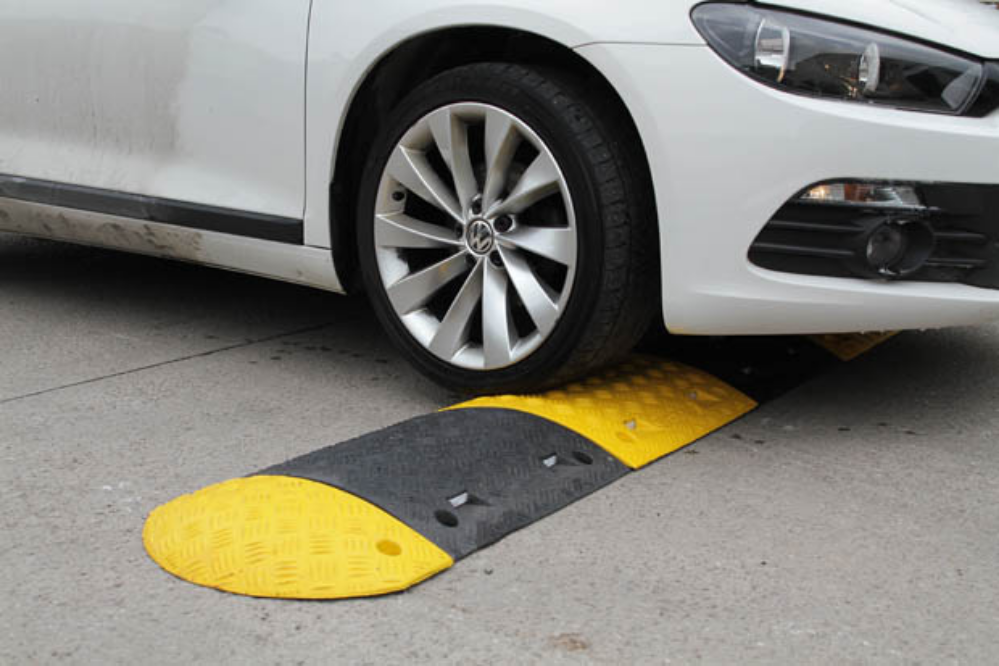
Road Hump | Speed Bump Applications
Traffic calming measures such as speed bumps are designed to slow traffic down and are usually used in residential or busy pedestrian areas. Successful speed limits should be self-enforcing through both good road design and clear signs. Traffic calming measures like humps and bumps can help enforce lower speed limits. However, critics point out that speed bumps have a number of unintended consequences. Some traffic may transfer to other roads to avoid the humps, moving the problem rather than solving it. And because drivers generally don't stick to a steady speed, the extra acceleration and braking caused by speed bumps can contribute to local air pollution.
Heavy-Duty Premium Grade Rubber Speed Bumps 1000 | Road Hump | Road Bump | Speed Hump | Rubber Road Hump
Road Hump | Speed Bump Applications
Do speed bumps work?
Traffic calming measures such as speed bumps are designed to slow traffic down and are usually used in residential or busy pedestrian areas.
Successful speed limits should be self-enforcing through both good road design and clear signs. Traffic calming measures like humps and bumps can help enforce lower speed limits.
However, critics point out that speed bumps have a number of unintended consequences. Some traffic may transfer to other roads to avoid the humps, moving the problem rather than solving it. And because drivers generally don't stick to a steady speed, the extra acceleration and braking caused by speed bumps can contribute to local air pollution.
Types of speed bumps and speed inhibitors
- Speed bumps: Designed by Compton, usually made of plastic or rubber and clearly marked with paint. According to UK law, they can be as high as 100mm, so that a car has to slow down to 5mph to navigate one without damage. Because they need such a significant speed reduction, they're most often used in parking lots, private roads and in some residential areas.
- Speed humps: Large bumps that span the entire width of the road. They look more like a feature of the road itself than speed bumps do, as they're covered in asphalt or tarmac. They also have a maximum height of 100mm, but they're usually not as tall as speed bumps. They’re often used in residential areas but they're not suitable for bus routes.
- Speed cushions: Essentially speed humps that have been broken up into discrete parts. They look like short rectangular lumps in the road that come in twos or threes, depending on the width of the road. Because they're broken up, emergency vehicles; with their wider axles; can pass over them without slowing down.
- Speed tables: Elongated road humps that taper up from road level to a flattened top over a longer distance. They can be used at a junction or to form a pedestrian crossing. And they're easier for heavier vehicles to get over.
- Chicanes: Artificially constructed bends that make the road into a snake-like shape. Drivers have to reduce speed to navigate the curves.
How should I drive over speed bumps?
Slowly. Driving over speed bumps too fast can potentially cause damage to your car.
If you drive over them slowly, you shouldn’t see any damage to your car at all, but over time, regularly driving over cushions can increase the wear on the inner shoulder of your tyres. Take the time to check your tyres every now and then.
The history of speed bumps
- Traffic calming first appeared around 1906 in Chatham, New Jersey, when the average speed of an automobile had reached 30mph.
- In 1953, a physicist named Arthur Holly Compton invented 'traffic control bumps’ – pretty much the rubber speed bumps we know and love today – to slow down cars whizzing past his university.
- It wasn't until 1970 that the first speed bump appeared in Europe, and speed humps finally made their way to Britain in 1983.
Are speed bumps the only way to calm traffic?
No. Many factors contribute to the increased road safety we’ve enjoyed over the years, including road design, vehicle design, driver education and enforcement. The right speed bump in the right place may improve safety but that doesn't mean all speed bumps make the road safer wherever they're put. While it should never be at the expense of road safety, the removal of some speed humps in cities could help improve traffic flow and reduce exhaust emissions.
The future of speed bumps
Most speed bumps and humps are little more than lumps of tarmac but the latest 'intelligent' speed bump is filled with a non-Newtonian liquid that hardens if you go too fast. The design means slow drivers won't be affected but motorists driving too fast will be met with a bump. These liquid speed bumps are currently only used in parts of Spain – where it was invented – but this could be the future of traffic calming across the world.
